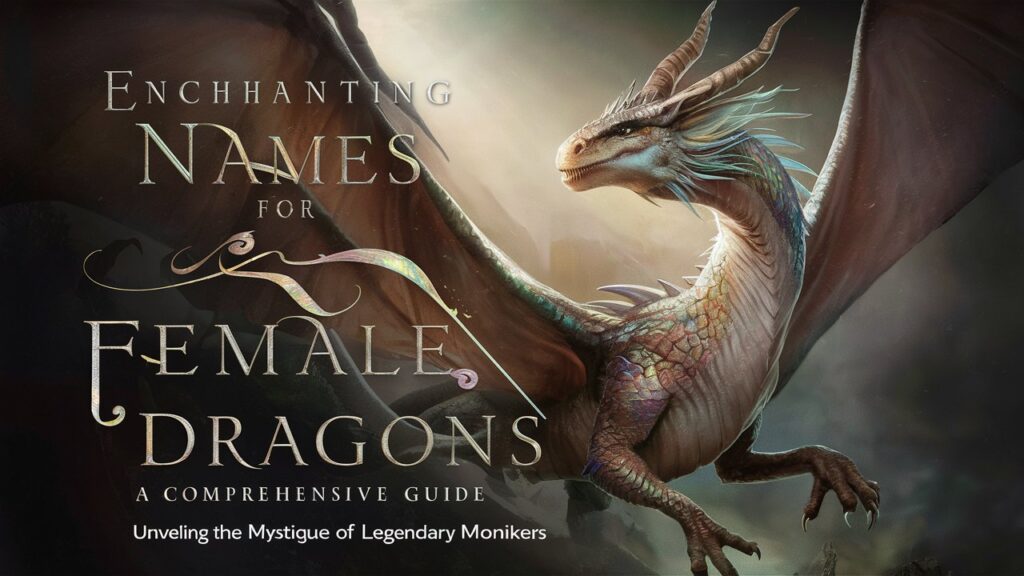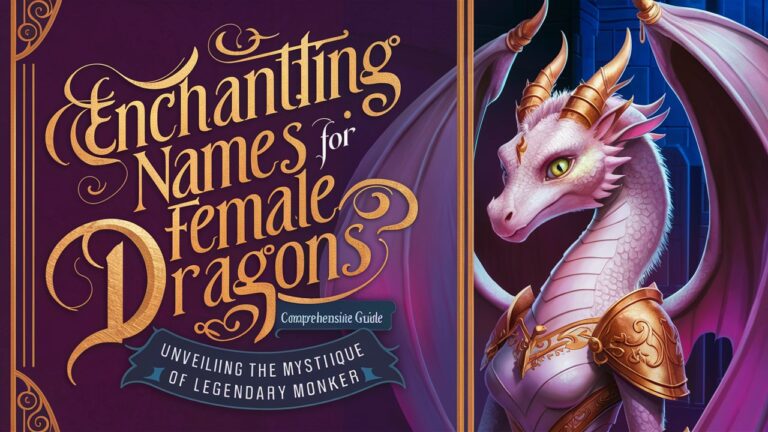Introduction: The Art of Naming Female Dragons
Dragons have captivated human imagination for millennia, symbolizing power, wisdom, and mystique. Naming a female dragon is no simple task—it requires balancing creativity, cultural resonance, and a touch of magic. Whether you’re crafting a fantasy novel, designing a game, or simply indulging in mythical worldbuilding, the right name can breathe life into your dragon character. Female dragons often embody grace alongside ferocity, and their names should reflect this duality. This article delves into diverse categories of names, from ancient mythologies to modern inspirations, ensuring you find the perfect fit for your winged protagonist.
1. Mythological and Legendary Female Dragon Names
Mythology offers a treasure trove of names steeped in history and symbolism. Tiamat, from Babylonian lore, reigns as the primordial goddess of chaos and the sea, embodying raw, untamed power. In Greek mythology, Echidna, the “Mother of Monsters,” pairs serpentine features with a fearsome reputation. For Eastern-inspired tales, Ryūko (Japanese for “dragon child”) or Longnu (a dragon maiden from Chinese folklore) evoke elegance and mysticism. These names carry centuries of storytelling weight, ideal for dragons with deep ties to ancient prophecies or divine origins.
2. Elemental and Nature-Inspired Dragon Names
Elemental themes resonate with dragons’ affinity for natural forces. Ignisia (from ignis, Latin for fire) suits a fiery, volcanic dragon, while Aqualira blends water (aqua) with light, perfect for a serpent ruling misty lakes. Earthier names like Terravia (terra + via, “earth path”) or Verdantia (evoking lush greenery) highlight a connection to forests or mountains. For air-based dragons, Zephyra (from Zephyrus, the Greek god of the west wind) suggests speed and ethereal grace. These names anchor your dragon in the natural world, amplifying their elemental traits.
3. Celestial and Cosmic Dragon Names
Dragons intertwined with the cosmos deserve names as vast as the night sky. Lunastra (combining luna and astra, “moon star”) shines for a dragon cloaked in moonlight. Andromedra fuses the Andromeda constellation with draconic grandeur, ideal for a celestial guardian. Nebulae or Solara (evoking the sun’s radiance) suit dragons embodying cosmic balance. These names work well in stories where dragons influence fate, seasons, or celestial phenomena, adding layers of otherworldly allure.
4. Feminine Elegance: Names Inspired by Beauty and Grace
Not all female dragons are warriors—some exude regal sophistication. Aurelia (meaning “golden”) or Seraphina (with roots in “seraphim,” angels of light) emphasize beauty and nobility. Luminara (light + aura) or Elysia (referencing Elysium, a paradise) conjure images of dragons as benevolent protectors. For a darker elegance, Nocturna (night-inspired) or Velastra (velvet + astra) blend mystery with refinement. These names are perfect for dragons who wield influence through diplomacy or enchantment rather than brute strength.
5. Modern and Unique Female Dragon Names
Contemporary storytelling often demands fresh, inventive names. Drakara or Vrykolina offer a modern twist on classic draconic sounds. Synderelle (hinting at “cinder”) or Frostara (frost + aura) merge elemental themes with originality. For a tech-inspired world, Cyberis or Neonira infuse futuristic flair. These names break from tradition while retaining the essence of dragon lore, ideal for urban fantasy or sci-fi crossovers.
6. Crafting Your Own Dragon Name: Tips and Tricks
Creating a unique name involves blending sounds, meanings, and cultural echoes. Start with root words—Latin, Greek, or Old Norse terms for elements like fire (ignis), shadow (umbra), or wings (ala). Add suffixes like -ra, -thia, or -lyn for femininity. For example, Umbrathia (shadow + grace) or Alarys (winged queen). Experiment with alliteration (Sylvara the Sky Serpent) or mashups (Thalassindra, merging thalassa (sea) with indra (strength)). Ensure the name’s rhythm matches your dragon’s personality—sharp syllables for aggressors, flowing vowels for wise matriarchs.

Conclusion: The Legacy of a Dragon’s Name
A dragon’s name is more than a label—it’s a narrative device that shapes her identity and legacy. From ancient myths to modern lexicons, the possibilities are as boundless as your imagination. Whether you choose a name echoing thunderous power or whispered elegance, let it reflect the soul of your dragon. After all, in the realms of fantasy, a name can be the spark that ignites an epic saga.
Frequently Asked Questions (FAQs)
Q1: Where can I find inspiration for female dragon names?
Look to mythology, nature, astronomy, and languages like Latin or Sanskrit. Even everyday words, when twisted creatively (Emberlyn, Stormweaver), can yield striking results.
Q2: How do female dragon names differ from male ones?
Female names often emphasize fluidity, grace, or mystical qualities (e.g., Lunara, Aureliss), whereas male names might lean toward harsh consonants or titles of dominion (Krogan, Drakthar).
Q3: Are there cultural taboos to avoid?
Research names from specific cultures to ensure respectful use. For example, using Ryūjin (a Japanese sea deity) without context could misrepresent its significance.
Q4: Can a dragon’s name influence her role in a story?
Absolutely! A name like Vespyria (evoking venom and fire) hints at a cunning, dangerous antagonist, while Caelis (sky-bound) suggests a guardian of the heavens.
Q5: Should I use existing names or invent my own?
Both work! Blend familiarity and novelty—Tiamat resonates with myth enthusiasts, while Zorythine offers fresh intrigue.
Craft your dragon’s name with care, and watch her soar from the pages into legend. 🐉✨
